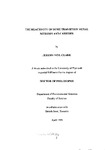THE REACTIVITY OF SOME TRANSITION METAL NITRIDES AND CARBIDES
| dc.contributor.author | CLARK, JEREMY NEIL | |
| dc.contributor.other | School of Geography, Earth and Environmental Sciences | en_US |
| dc.date.accessioned | 2013-09-19T13:06:32Z | |
| dc.date.available | 2013-09-19T13:06:32Z | |
| dc.date.issued | 1995 | |
| dc.identifier | NOT AVAILABLE | en_US |
| dc.identifier.uri | http://hdl.handle.net/10026.1/1891 | |
| dc.description.abstract |
The formation and oxidation of transition metal nitrides and carbides is reviewed and the crystal structures and types of bonding are discussed. Types of nitrides and carbides are categorized in terms of physical and chemical properties and type of bonding. The principles of sintering are summarised. Tlie theory and applications of thermal analytical techniques are reviewed. Surface area determination and estimation of average crystallite size by the BET method utilizing the adsorption of nitrogen gas at -196 X are explained along with the application of x-ray dififractometry ajid scanning electron microscopy to work in this area. In this present research selected transition metal nitrides and carbides have been oxidised in air and carbon dioxide. Activation energies have been determined for these reactions from isothennal oxidations utilizing the Arrhenius equation and from oxidations at different heating rates utilizing the Kissinger equation. Kinetic schemes for the isothermal oxidations have been proposed based on two models of the reactions, that is half order kinetics in which the rate of reaction is determined by the diffijsion of oxidising gas througli the oxide product and two-thirds order kinetics in which the reaction takes place at the surface of a spherical particle of diminishing size as the reaction pioceeds. Surface area measurements and electron microscopy have been utilized to study the ability of the product formed during the oxidations to sinter. X-ray diffractometry has been used to identify the crystal phases present in the initial nitride or carbide and in the oxidation products. The activation energies of the carbides were found to be lower than that found for the respective nitrides. At low temperatures the carbides oxidised more extensively than the respective nitrides, but at high temperatures the situation was reversed. This is explained in terms of the difference in the preexponential term of the Arrhenius equation. Tlie kinetics were found to be dependent on whether the oxide produced was structurally compatible with the remaining reactant and whether the oxide produced was able to sinter at the temperature used in the experiment. | en_US |
| dc.description.sponsorship | British Steel, Teesside | en_US |
| dc.language.iso | en | en_US |
| dc.publisher | University of Plymouth | en_US |
| dc.title | THE REACTIVITY OF SOME TRANSITION METAL NITRIDES AND CARBIDES | en_US |
| dc.type | Thesis | |
| plymouth.version | Full version | en_US |
| dc.identifier.doi | http://dx.doi.org/10.24382/3220 | |
| dc.identifier.doi | http://dx.doi.org/10.24382/3220 |
Files in this item
This item appears in the following Collection(s)
-
01 Research Theses Main Collection
Research Theses Main


